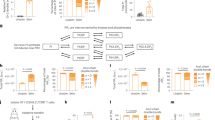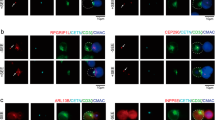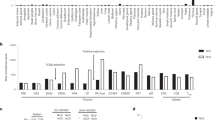Abstract
T cell activation is triggered by several hours of contact with peptide–major histocompatibility (MHC) complexes on the surface of antigen-presenting cells (APCs). The nature and location of the sustained signal transduction pathways required for T cell activation are unknown. We show here that the production of phosphatidylinositol(3,4,5)triphosphate (PIP3) was dynamically sustained for hours as T cells responded to antigen. In addition, sustained elevation of PIP3 was essential for T cell proliferation. There was PIP3 accumulation in the T cell–APC contact zone and at the antipodal pole of the cell. The immune synapse is thus not the sole site of sustained signal transduction in activated T cells.
This is a preview of subscription content, access via your institution
Access options
Subscribe to this journal
Receive 12 print issues and online access
$209.00 per year
only $17.42 per issue
Buy this article
- Purchase on Springer Link
- Instant access to full article PDF
Prices may be subject to local taxes which are calculated during checkout







Similar content being viewed by others
References
Ward, S.G. & Cantrell, D.A. Phosphoinositide 3-kinases in T lymphocyte activation. Curr. Opin. Immunol. 13, 332–338 (2001).
Cantrell, D.A. Phosphoinositide 3-kinase signalling pathways. J. Cell Sci. 114, 1439–1445 (2001).
Cantrell, D. Protein kinase B (Akt) regulation and function in T lymphocytes. Semin. Immunol. 14, 19–26 (2002).
Vanhaesebroeck, B. & Alessi, D.R. The PI3K-PDK1 connection: more than just a road to PKB. Biochem. J. 346, 561–576 (2000).
Fruman, D.A. & Cantley, L.C. Phosphoinositide 3-kinase in immunological systems. Semin. Immunol. 14, 7–18 (2002).
Reif, K., Nobes, C.D., Thomas, G., Hall, A. & Cantrell, D.A. Phosphatidylinositol 3-kinase signals activate a selective subset of Rac/Rho-dependent effector pathways. Curr. Biol. 6, 1445–1455 (1996).
Okkenhaug, K. et al. Impaired B and T cell antigen receptor signaling in p110δ PI3-kinase mutant mice. Science 297, 1031–1034 (2002).
Kane, L.P., Andres, P.G., Howland, K.C., Abbas, A.K. & Weiss, A. Akt provides the CD28 costimulatory signal for up-regulation of IL-2 and IFN-γ but not TH2 cytokines. Nature Immunol. 2, 37–44 (2001).
Rathmell, J.C., Farkash, E.A., Gao, W. & Thompson, C.B. IL-7 enhances the survival and maintains the size of naive T cells. J. Immunol. 167, 6869–6876 (2001).
Frauwirth, K.A. et al. The CD28 signaling pathway regulates glucose metabolism. Immunity 16, 769–777 (2002).
Burgering, B.M. & Kops, G.J. Cell cycle and death control: long live Forkheads. Trends Biochem. Sci. 27, 352–360 (2002).
Brennan, P. et al. Phosphatidylinositol 3-kinase controls E2F transcriptional activity in response to interleukin-2. Immunity 7, 679–689 (1997).
Nunes, J.A., Collette, Y., Truneh, A., Olive, D. & Cantrell, D.A. The role of p21ras in CD28 signal transduction: Triggering of CD28 with antibodies, but not the ligand B7-1 activates p21ras. J. Exp. Med. 180, 1067–1076 (1994).
Ward, S.G., Ley, S.C., MacPhee, C. & Cantrell, D.A. Regulation of D-3 phosphoinositides during T cell activation via the T cell antigen receptor/CD3 complex and CD2 antigens. Eur. J. Immunol. 22, 45–49 (1992).
Lafont, V., Astoul, E., Laurence, A., Liautard, J. & Cantrell, D. The T cell antigen receptor activates phosphatidylinositol 3-kinase-regulated serine kinases protein kinase B and ribosomal S6 kinase 1. FEBS Lett. 486, 38–42 (2000).
Delon, J., Bercovici, N., Liblau, R. & Trautmann, A. Imaging antigen recognition by naive CD4+ T cells: compulsory cytoskeletal alterations for the triggering of an intracellular calcium response. Eur. J. Immunol. 28, 716–729 (1998).
Delon, J., Bercovici, N., Raposo, G., Liblau, R. & Trautmann, A. Antigen-dependent and -independent Ca2+ responses triggered in T cells by dendritic cells compared with B cells. J. Exp. Med. 188, 1473–1484 (1998).
Donnadieu, E. et al. Imaging early steps of human T cell activation by antigen-presenting cells. J. Immunol. 148, 2643–2653 (1992).
Revy, P., Sospedra, M., Barbour, B. & Trautmann, A. Functional antigen-independent synapses formed between T cells and dendritic cells. Nature Immunol. 2, 925–931 (2001).
Lee, K.H. et al. T cell receptor signaling precedes immunological synapse formation. Science 295, 1539–1542 (2002).
Meyer, T. & Oancea, E. Studies of signal transduction events using chimeras to green fluorescent protein. Meth. Enzymol. 327, 500–513 (2000).
Teruel, M.N. & Meyer, T. Translocation and reversible localization of signaling proteins: a dynamic future for signal transduction. Cell 103, 181–184 (2000).
Teruel, M.N. & Meyer, T. Parallel single-cell monitoring of receptor-triggered membrane translocation of a calcium-sensing protein module. Science 295, 1910–1912 (2002).
Matthews, S., Iglesias, T., Cantrell, D. & Rozengurt, E. Dynamic re-distribution of protein kinase D (PKD) as revealed by a GFP-PKD fusion protein: dissociation from PKD activation. FEBS Lett. 457, 515–521 (1999).
Matthews, S.A., Iglesias, T., Rozengurt, E. & Cantrell, D. Spatial and temporal regulation of protein kinase D (PKD). EMBO J. 19, 2935–2945 (2000).
Haugh, J.M., Codazzi, F., Teruel, M. & Meyer, T. Spatial sensing in fibroblasts mediated by 3′ phosphoinositides. J. Cell Biol. 151, 1269–1280 (2000).
Marshall, J.G. et al. Restricted accumulation of phosphatidylinositol 3-kinase products in a plasmalemmal subdomain during Fcγ receptor-mediated phagocytosis. J. Cell Biol. 153, 1369–1380 (2001).
Astoul, E., Watton, S. & Cantrell, D. The dynamics of protein kinase B regulation during B cell antigen receptor engagement. J. Cell Biol. 145, 1511–1520 (1999).
Watton, S.J. & Downward, J. Akt/PKB localisation and 3′ phosphoinositide generation at sites of epithelial cell-matrix and cell-cell interaction. Curr. Biol. 9, 433–436 (1999).
Meili, R. et al. Chemoattractant-mediated transient activation and membrane localization of Akt/PKB is required for efficient chemotaxis to cAMP in Dictyostelium. EMBO J. 18, 2092–2105 (1999).
Dustin, M.L. & Cooper, J.A. The immunological synapse and the actin cytoskeleton: molecular hardware for T cell signaling. Nature Immunol. 1, 23–29 (2000).
Grakoui, A. et al. The immunological synapse: a molecular machine controlling T cell activation. Science 285, 221–227 (1999).
Bromley, S.K. et al. The immunological synapse. Annu. Rev. Immunol. 19, 375–396 (2001).
Monks, C.R., Freiberg, B.A., Kupfer, H., Sciaky, N. & Kupfer, A. Three-dimensional segregation of supramolecular activation clusters in T cells. Nature 395, 82–86 (1998).
Potter, T.A., Grebe, K., Freiberg, B. & Kupfer, A. Formation of supramolecular activation clusters on fresh ex vivo CD8+ T cells after engagement of the T cell antigen receptor and CD8 by antigen-presenting cells. Proc. Natl. Acad. Sci. USA 98, 12624–12629 (2001).
Cantrell, D.A. Transgenic analysis of thymocyte signal transduction. Nature Rev. Immunol. 2, 20–27 (2002).
Singbartl, K. et al. A CD2-green fluorescence protein-transgenic mouse reveals very late antigen-4-dependent CD8+ lymphocyte rolling in inflamed venules. J. Immunol. 166, 7520–7526 (2001).
Mamalaki, C. et al. T cell deletion follows chronic antigen specific T cell activation in vivo. Int. Immunol. 5, 1285–1292 (1993).
Pircher, H., Burki, K., Lang, R., Hengartner, H. & Zinkernagel, R.M. Tolerance induction in double specific T-cell receptor transgenic mice varies with antigen. Nature 342, 559–561 (1989).
Lanzavecchia, A. & Sallusto, F. From synapses to immunological memory: the role of sustained T cell stimulation. Curr. Opin. Immunol. 12, 92–98 (2000).
Lanzavecchia, A. Understanding the mechanisms of sustained signaling and T cell activation. J. Exp. Med. 185, 1717–1719 (1997).
Lezzi, G., Karjalainen, K. & Lanzavecchia, A. The duration of antigenic stimulation determines the fate of naive and effector T cells. Immunity 8, 89–95 (1998).
Astoul, E., Edmunds, C., Cantrell, D.A. & Ward, S.G. PI 3-K and T-cell activation: limitations of T-leukemic cell lines as signaling models. Trends Immunol. 22, 490–496 (2001).
Stinchcombe, J.C., Bossi, G., Booth, S. & Griffiths, G.M. The immunological synapse of CTL contains a secretory domain and membrane bridges. Immunity 15, 751–761 (2001).
van Der Merwe, P.A. & Davis, S.J. Immunology. The immunological synapse–a multitasking system. Science 295, 1479–1480 (2002).
Ni, H.T., Deeths, M.J. & Mescher, M.F. LFA-1-mediated costimulation of CD8+ T cell proliferation requires phosphatidylinositol 3-kinase activity. J. Immunol. 166, 6523–6529 (2001).
Delon, J., Kaibuchi, K. & Germain, R.N. Exclusion of CD43 from the immunological synapse is mediated by phosphorylation-regulated relocation of the cytoskeletal adaptor moesin. Immunity 15, 691–701 (2001).
Sperling, A.I. et al. TCR signaling induces selective exclusion of CD43 from the T cell-antigen-presenting cell contact site. J. Immunol. 161, 6459–6462 (1998).
Roumier, A. et al. The membrane-microfilament linker ezrin is involved in the formation of the immunological synapse and in T cell activation. Immunity 15, 715–728 (2001).
Zhumabekov, T., Corbella, P., Tolaini, M. & Kioussis, D. Improved version of a human CD2 minigene based vector for T cell-specific expression in transgenic mice. J. Immunol. Meth. 185, 133–140 (1995).
Acknowledgements
We thank I. Rosewell for injection of transgenic constructs; T. Grafton, S. Hoskins, J. Bee and G. Hutchinson for animal care; and P. Jordan, D. Zicha and J. Monypenny for help with confocal microscopy. Supported by the Fondation pour la Recherche Medicale (M. G.) and Cancer Research UK (P. S. C. and D. A. C.).
Author information
Authors and Affiliations
Corresponding author
Ethics declarations
Competing interests
The authors declare no competing financial interests.
Rights and permissions
About this article
Cite this article
Costello, P., Gallagher, M. & Cantrell, D. Sustained and dynamic inositol lipid metabolism inside and outside the immunological synapse. Nat Immunol 3, 1082–1089 (2002). https://doi.org/10.1038/ni848
Received:
Accepted:
Published:
Issue Date:
DOI: https://doi.org/10.1038/ni848
This article is cited by
-
Regulation of T cell signalling by membrane lipids
Nature Reviews Immunology (2016)
-
A septin requirement differentiates autonomous and contact-facilitated T cell proliferation
Nature Immunology (2016)
-
Molecular mechanisms and functional implications of polarized actin remodeling at the T cell immunological synapse
Cellular and Molecular Life Sciences (2015)
-
Serine-threonine kinases in TCR signaling
Nature Immunology (2014)
-
Piperine inhibits type II phosphatidylinositol 4-kinases: a key component in phosphoinositides turnover
Molecular and Cellular Biochemistry (2014)



